|  Linear Functions: Linear Functions: Yous are already familiar with the concept of "average charge per unit of change".
When working with straight lines (linear functions) you saw the "average rate of change" to be: 
| The word "slope" may besides be referred to as "gradient", "incline" or "pitch", and be expressed as:
 A special circumstance exists when working with straight lines (linear functions), in that the "average rate of change" (the slope) is constant. No affair where y'all check the slope on a straight line, you lot will get the aforementioned answer. | 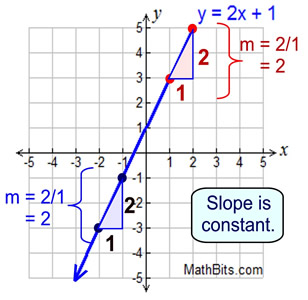 |  Not-linear Functions: Not-linear Functions: When working with non-linear functions, the "boilerplate rate of change" is not constant. The process of computing the "average rate of change", however, remains the same every bit was used with straight lines: two points are chosen, and  is computed. is computed. FYI: You will larn in later courses that the "average rate of change" in non-linear functions is really the slope of the secant line passing through the ii called points. A secant line cuts a graph in two points. | 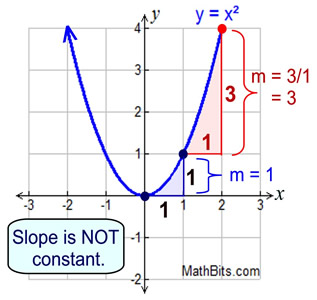 | When y'all detect the "average rate of change" you are finding the charge per unit at which (how fast) the part'southward y-values (output) are changing as compared to the function'south x-values (input). When working with functions (of all types), the "boilerplate charge per unit of modify" is expressed using part annotation. Average Charge per unit of Modify
For the function y = f (x) betwixt ten = a and x = b, the  ( b - a ≠ 0) ( b - a ≠ 0)
 A closer look at this "general" average rate of alter formula: A closer look at this "general" average rate of alter formula: While this new formula may expect strange, it is really simply a re-write of  . . Think that y = f (x).
Then, when working with points (x one, y 1) and (x ii, y 2), we can also write them equally the points  . .
So our slope formula can be expressed every bit  . . If nosotros rename 10 one to exist a, and x 2 to be b, we volition have the new formula. The points are  , and the , and the  where ( b - a ≠ 0). where ( b - a ≠ 0). |   If instead of using (a, f (a)) and (b, f (b)) equally the points, we use the points
(x, f (x)) and (x + h, f (x + h)), we get:

This expression was seen in evaluating functions. It is a popular expression, called the deviation quotient, and will announced in hereafter courses. Discover, as h approaches 0 (gets closer to 0), the secant line becomes a tangent line. | 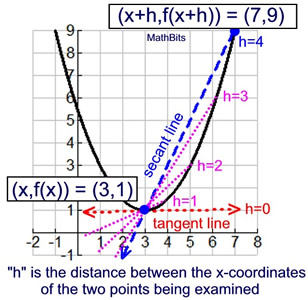 |
Average Charge per unit of Change
The average charge per unit of change is the slope of the secant line
between x = a and x = b on the graph of f (x).
The secant line passes through the points (a, f (a)) and (b, f (b)).  Negative Rate of Alter: Negative Rate of Alter: | The graph at the right shows an average rate of change on the function f (x) = x 2 - 3 from indicate (-2,1) to (0,-3). The segment connecting the points is part of a secant line.
 This average charge per unit of change is negative. | 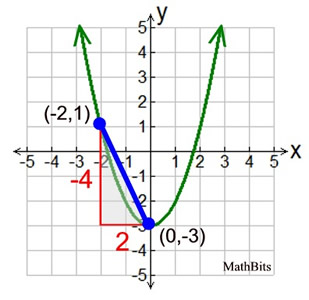 |  An average rate of change of 4/(-2), means that for every ii units of movement to the right on the x-axis on this interval, there volition be 4 units of change on the y-axis. The negative sign indicates that the y-change movement will be in a negative direction (downward) producing at least a decreasing portion of the graph somewhere on this interval (if not the entire interval). An average rate of change of 4/(-2), means that for every ii units of movement to the right on the x-axis on this interval, there volition be 4 units of change on the y-axis. The negative sign indicates that the y-change movement will be in a negative direction (downward) producing at least a decreasing portion of the graph somewhere on this interval (if not the entire interval). An accustomed interpretation: an average charge per unit of change of -2, for example, is to be interpreted every bit a "rate of alter of 2 in a negative direction". [NOTE: The "corporeality" of a rate of alter is adamant past its absolute value. A rate of modify of -3 would be considered "greater" than a rate of change of +2, assuming the units are the aforementioned in both cases.]
Average Rate of Change and Increasing/Decreasing
When the average rate of change is positive, the graph has increased on that interval. When the average rate of change is negative , the graph has decreased on that interval.
| Did you observe the "conscientious" wording relating to " has increased " and " has decreased " in the box to a higher place?
The " increased " argument, for case, does NOT say that the function volition exist necessarily increasing on the Unabridged interval. It may just exist increasing on a portion of the interval. We tin can say that: "If a function is continually increasing on an interval, its average rate of alter on that interval is positive." But we cannot say that: "If a function'south average rate of modify on an interval is positive, the function is continually increasing on that interval." | 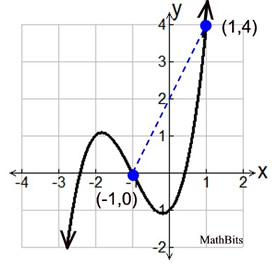 | Run into the counterexample at the right for function f (10) = x 3 + 3x 2 + x - 1.
From (-1,0) to (1,4) the boilerplate rate of alter is (iv-0)/(i-(-1)) = +ii, a positive value. But the graph is Not INCREASING on the unabridged interval from (-1,0) to (ane,4). Aye, More of the interval is increasing than is decreasing, but the entire interval is not increasing. |  Zero Rate of Change: Zero Rate of Change: | The graph at the right shows average charge per unit of change on the role f (x) = x 2 - 3 from point (-1,-2) to (i,-2).
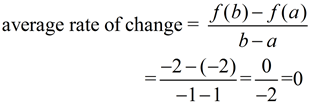 This average charge per unit of change is zero. A zero charge per unit of alter is achieved when f (b) = f (a) giving a numerator of null.
| 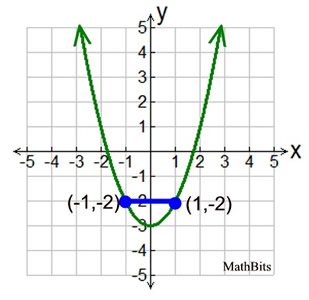 | When the average rate of modify is zero, the sum of all possible positive slopes and negative slopes on the interval volition be zero. The sum of the possible positive slopes cancels out the sum of the possible negative slopes.   Examples: Examples:  Finding average rate of change from a table. Finding average rate of change from a table. Part f (10) is shown in the table at the right.
Discover the average rate of change over the interval ane < x < three.
Solution:
If the interval is 1 < x < three, so you are examining the points (one,4) and (3,16). From the first indicate, permit a = 1, and f (a) = 4. From the second indicate, permit b = 3 and f (b) = 16.
Substitute into the formula: 
| | | The average rate of change is vi over 1, or just half-dozen.
The y-values change 6 units every time the x-values modify ane unit of measurement, on this interval. |  Finding average rate of change from a graph. Finding average rate of change from a graph. Function g (ten) is shown in the graph at the correct.
Find the boilerplate rate of change over the interval
i < x < four.
Solution:
If the interval is 1 < ten < 4, then you are examining the points (1,ane) and (iv,2), as seen on the graph. From the first point, allow a = 1, and g (a) = 1. From the second bespeak, let b = 4 and g (b) = 2.
Substitute into the formula: 
| 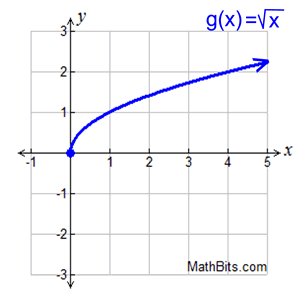 | | The average rate of change is i over 3, or merely 1/3.
The y-values change one unit every fourth dimension the 10-values modify iii units, on this interval. |  Finding average rate of modify from a word problem. Finding average rate of modify from a word problem. A ball thrown in the air has a height of h(t) = - 16t² + fiftyt + iii feet
subsequently t seconds.
a) What are the units of measurement for the average charge per unit of alter
of h?
b) Find the boilerplate rate of change of h between t = 0 and t = 2? |  | Solution:
a) In the formula,  , the numerator (top) is measured in feet and the denominator (lesser) is measured in seconds. This ratio is measured in anxiety per 2nd, which will be the velocity of the ball. , the numerator (top) is measured in feet and the denominator (lesser) is measured in seconds. This ratio is measured in anxiety per 2nd, which will be the velocity of the ball.
b) Commencement past finding h(t) when t = 0 and t = ii, by plugging the t values into h(t).
h(two) = -16(2)² + 50(2) + 3 = 39
h(0) = -16(0)² + 50(0) + 3 = 3
Now, employ the average rate of change formula:
 | |  Comparing average rates of alter. Comparing average rates of alter. Given the part shown at the right.
State whether the post-obit statements are TRUE or FALSE:
a) boilerplate rate of modify from B to A is greater than average charge per unit of change from East to A.
b) boilerplate charge per unit of modify from B to A is greater than boilerplate rate of alter from D to C. Solution:
a) average charge per unit of alter on B to A =
(4 - 0)/(iii - 1.25) ≈ 2.285
average charge per unit of change on E to A =
(0 - 4)/(-4.five - 3) ≈ 0.533
TRUE |  | b) average rate of alter on B to A ≈ ii.285
boilerplate rate of modify on D to C = (5 - (-3))/(-three - 0) ≈ -ii.667
READ CAREFULLY!!!
Simulated
Nosotros know mathematically that two.285 > -2.667. In this situation, still, the negative sign simply designates "management" (decreasing in this case). The decrease from D to C is changing at a rate faster than the rate of increase from B to A. The rate of change of 2.667 is greater than that of 2.285. And so, the answer to the question is FALSE.
| |  NOTE: The re-posting of materials (in office or whole) from this site to the Internet is copyright violation
and is non considered "fair utilize" for educators. Please read the "Terms of Utilize". |




 is computed.
is computed.
 ( b - a ≠ 0)
( b - a ≠ 0) .
. .
.












 , the numerator (top) is measured in feet and the denominator (lesser) is measured in seconds. This ratio is measured in anxiety per 2nd, which will be the velocity of the ball.
, the numerator (top) is measured in feet and the denominator (lesser) is measured in seconds. This ratio is measured in anxiety per 2nd, which will be the velocity of the ball.


0 Response to "Can The Average Rate Of Change Of An Increasing Function Ever Be Negative"
Post a Comment